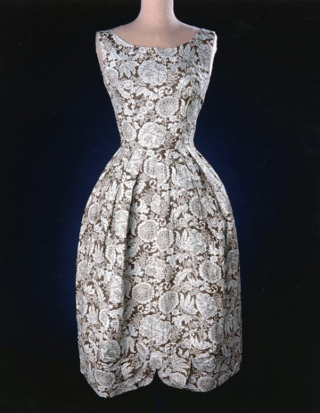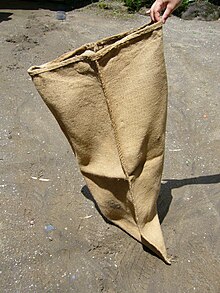
Yarn is a long continuous length of interlocked fibres, used in sewing, crocheting, knitting, weaving, embroidery, ropemaking, and the production of textiles. Thread is a type of yarn intended for sewing by hand or machine. Modern manufactured sewing threads may be finished with wax or other lubricants to withstand the stresses involved in sewing. Embroidery threads are yarns specifically designed for needlework. Yarn can be made of a number of natural or synthetic materials, and comes in a variety of colors and thicknesses. Although yarn may be dyed different colours, most yarns are solid coloured with a uniform hue.

A rug is a piece of cloth, similar to a carpet, but it does not span the width of a room and is not attached to the floor. It is generally used as a floor covering, or as a decorative feature.

Jute is a long, rough, shiny bast fiber that can be spun into coarse, strong threads. It is produced from flowering plants in the genus Corchorus, of the mallow family Malvaceae. The primary source of the fiber is Corchorus olitorius, but such fiber is considered inferior to that derived from Corchorus capsularis.

A ghillie suit is a type of camouflage clothing designed to resemble the background environment - such as foliage, snow or sand. Typically, it is a net or cloth garment covered in loose strips of burlap (hessian), cloth, or twine, sometimes made to look like leaves and twigs, and optionally augmented with scraps of foliage from the area.

A sandbag or dirtbag is a bag or sack made of hessian (burlap), polypropylene or other sturdy materials that is filled with sand or soil and used for such purposes as flood control, military fortification in trenches and bunkers, shielding glass windows in war zones, ballast, counterweight, and in other applications requiring mobile fortification, such as adding improvised additional protection to armored vehicles or tanks.

Bedding, also called bedclothes or bed linen, is the materials laid above the mattress of a bed for hygiene, warmth, protection of the mattress, and decorative effect. Bedding is the removable and washable portion of a human sleeping environment. Multiple sets of bedding for each bed are often washed in rotation and/or changed seasonally to improve sleep comfort at varying room temperatures. Most standardized measurements for bedding are rectangular, but there are also some square-shaped sizes, which allows the user to put on bedding without having to consider its lengthwise orientation.

A coffee bag is a container for shipping and storing coffee. Coffee beans are usually transported in large jute sacks, while coffee sold to consumers may be packaged as beans or ground coffee in a small, sealed plastic bag.
The jute trade is centered mainly around India's West Bengal and Assam, and Bangladesh. The major producing country of jute is India and biggest exporter is Bangladesh, due to their natural fertile soil. Production of jute by India and Bangladesh are respectively 1.968 million ton and 1.349 million metric ton. Bengal jute was exported to South East Asia from the 17th century by the Dutch, French and later by other Europeans.

Hessian, burlap in the United States and Canada, or crocus in Jamaica and the wider Caribbean, is a woven fabric made of vegetable fibres, usually the skin of the jute plant or sisal leaves. It is generally used for duties of rough handling, such as making sacks employed to ship farm products and to act as covers for sandbags, and for wrapping tree-root balls. However, this dense woven fabric, historically coarse, more recently is being produced in a refined state, known simply as jute, as an eco-friendly material for bags, rugs, and other products.

Rug hooking is both an art and a craft where rugs are made by pulling loops of yarn or fabric through a stiff woven base such as burlap, linen, or rug warp. The loops are pulled through the backing material by using a crochet-type hook mounted in a handle for leverage. In contrast latch-hooking uses a hinged hook to form a knotted pile from short, pre-cut pieces of yarn.

A wool bale is a standard sized and weighted pack of classed wool compressed by the mechanical means of a wool press. This is the regulation required method of packaging for wool, to keep it uncontaminated and readily identifiable. A "bale of wool" is also the standard trading unit for wool on the wholesale national and international markets.

Bast fibre is plant fibre collected from the phloem or bast surrounding the stem of certain dicotyledonous plants. It supports the conductive cells of the phloem and provides strength to the stem. Some of the economically important bast fibres are obtained from herbs cultivated in agriculture, as for instance flax, hemp, or ramie, but bast fibres from wild plants, as stinging nettle, and trees such as lime or linden, willow, oak, wisteria, and mulberry have also been used in the past. Bast fibres are classified as soft fibres, and are flexible. Fibres from monocotyledonous plants, called "leaf fibre", are classified as hard fibres and are stiff.
The manufacture of textiles is one of the oldest of human technologies. To make textiles, the first requirement is a source of fiber from which a yarn can be made, primarily by spinning. The yarn is processed by knitting or weaving, which turns yarn into cloth. The machine used for weaving is the loom. For decoration, the process of colouring yarn or the finished material is dyeing. For more information of the various steps, see textile manufacturing.

A flexible intermediate bulk container (FIBC), jumbo, bulk bag, super sack, big bag, or tonne bag is an industrial container made of flexible fabric that is designed for storing and transporting dry, flowable products, such as sand, fertilizer, and granules of plastic.

A bolt is a piece of cloth woven on a loom or created by a knitting machine, as it is processed, stored and/or marketed. Consequently, its dimensions are highly variable – flexible and dependent upon the manufacturing, machinery, quantity, size, thickness and quality of the product. It is a unit used in manufacturing, transport and inventory. It is also used as a descriptor for wallpaper, which uses different fabrication machinery. Being encompassing, it is by its nature a generic and ambiguous term of convenience and context, used to describe fabric and wallpaper.

Pompeii Airfield is an abandoned World War II military airfield in Italy, located approximately one km (0.62 mi) south of Terzigno, a few kilometers east of the base of Mount Vesuvius, and approximately 20 km (12 mi) east-southeast of Naples.

A bag is a common tool in the form of a non-rigid container, typically made of cloth, leather, paper or plastic. The use of bags predates recorded history, with the earliest bags being lengths of animal skin, cotton, or woven plant fibers, folded up at the edges and secured in that shape with strings of the same material. Bags can be used to carry items such as personal belongings, groceries, and other objects. They comes in various shapes and sizes, often equipped with handles or straps for easier carrying.
The jute industry is a historically and culturally important industry in Bangladesh dating back to during the growth of the East India Company in the Indian subcontinent. Despite once being one of the country's biggest industries and major export items, the jute industry has declined since the 1970s. Exports have fallen as other countries grow jute independently, decreasing the demand for jute to be exported, and other products like plastics and hemp find more widespread use. As of 2018, Bangladesh produces 33 percent of the total worldwide production of jute.

Feed sack dresses, flour sack dresses, or feedsack dresses were a common article of clothing in rural US and Canadian communities from the late 19th century through the mid 20th century. They were made at home, usually by women, using the cotton sacks in which flour, sugar, animal feed, seeds, and other commodities were packaged, shipped, and sold. They became an iconic part of rural life from the 1920s through the Great Depression, World War II, and post-World War II years.
Tat Patti ( Tat pati) is an indigenous floor cover of narrow width made of coarse Jute. It was produced in Punjab region. Tat patti was utilized as seating for students in government schools and provided to inmates in jail as well. It is still in use in rural India.
















